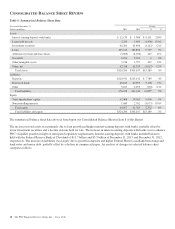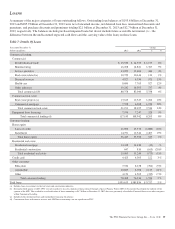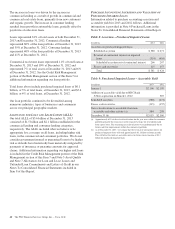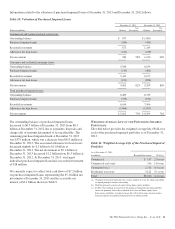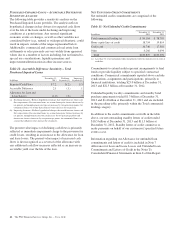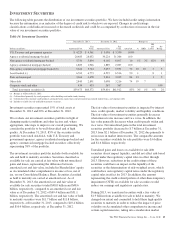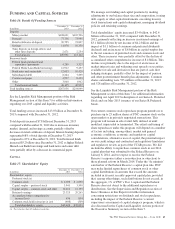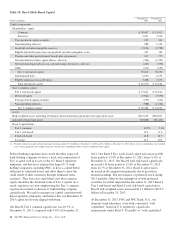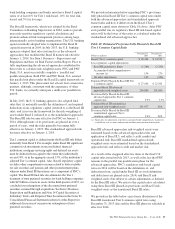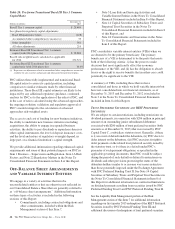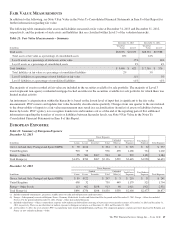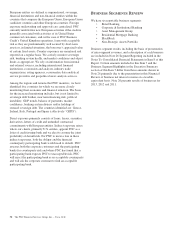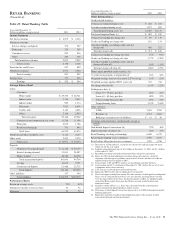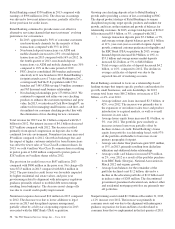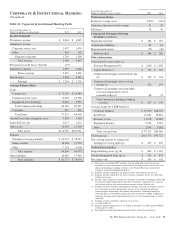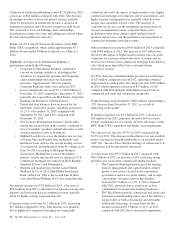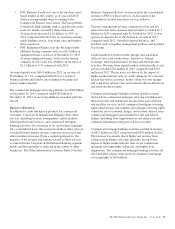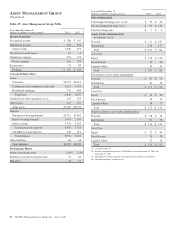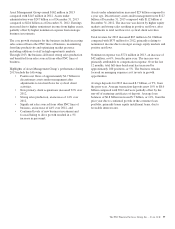PNC Bank 2013 Annual Report Download - page 65
Download and view the complete annual report
Please find page 65 of the 2013 PNC Bank annual report below. You can navigate through the pages in the report by either clicking on the pages listed below, or by using the keyword search tool below to find specific information within the annual report.
bank holding companies and banks must have Basel I capital
ratios of at least 6% for Tier 1 risk-based, 10% for total risk-
based, and 5% for leverage.
The Basel II framework, which was adopted by the Basel
Committee on Banking Supervision in 2004, seeks to provide
more risk-sensitive regulatory capital calculations and
promote enhanced risk management practices among large,
internationally active banking organizations. The U.S. banking
agencies initially adopted rules to implement the Basel II
capital framework in 2004. In July 2013, the U.S. banking
agencies adopted final rules (referred to as the advanced
approaches) that modified the Basel II framework effective
January 1, 2014. See Item 1 Business – Supervision and
Regulation and Item 1A Risk Factors in this Report. Prior to
fully implementing the advanced approaches established by
these rules to calculate risk-weighted assets, PNC and PNC
Bank, N.A. must successfully complete a “parallel run”
qualification phase. Both PNC and PNC Bank, N.A. entered
this parallel run phase under the Basel II capital framework on
January 1, 2013. This phase must last at least four consecutive
quarters, although, consistent with the experience of other
U.S. banks, we currently anticipate a multi-year parallel run
period.
In July 2013, the U.S. banking agencies also adopted final
rules that: (i) materially modify the definition of, and required
deductions from, regulatory capital (referred to as the Basel III
rule); and (ii) revise the framework for the risk-weighting of
assets under Basel I (referred to as the standardized approach).
The Basel III rule became effective for PNC on January 1,
2014, although many of its provisions are phased-in over a
period of years, with the rules generally becoming fully
effective on January 1, 2019. The standardized approach rule
becomes effective on January 1, 2015.
Tier 1 common capital as defined under the Basel III rule differs
materially from Basel I. For example, under Basel III, significant
common stock investments in unconsolidated financial
institutions, mortgage servicing rights and deferred tax assets
must be deducted from capital to the extent they individually
exceed 10%, or in the aggregate exceed 15%, of the institution’s
adjusted Tier 1 common capital. Also, Basel I regulatory capital
excludes other comprehensive income related to both available
for sale securities and pension and other postretirement plans,
whereas under Basel III these items are a component of PNC’s
capital. The Basel III final rule also eliminates the Tier 1
treatment of trust preferred securities for bank holding companies
with $15 billion or more in assets. In the third quarter of 2013, we
concluded our redemptions of the discounted trust preferred
securities assumed through acquisitions. See Item 1 Business-
Supervision and Regulation and Note 14 Capital Securities of
Subsidiary Trusts and Perpetual Trust Securities in the Notes To
Consolidated Financial Statements in Item 8 of this Report for
additional discussion of our previous redemptions of trust
preferred securities.
We provide information below regarding PNC’s pro forma
fully phased-in Basel III Tier 1 common capital ratio under
both the advanced approaches and standardized approach
frameworks and how it differs from the Basel I Tier 1
common capital ratios shown in Table 18 above. After PNC
exits parallel run, its regulatory Basel III risk-based capital
ratios will be the lower of the ratios as calculated under the
standardized and advanced approaches.
Table 19: Estimated Pro forma Fully Phased-In Basel III
Tier 1 Common Capital Ratio
Dollars in millions
December 31
2013
December 31
2012
Basel I Tier 1 common capital $ 28,484 $ 24,951
Less regulatory capital adjustments:
Basel III quantitative limits (1,386) (2,330)
Accumulated other comprehensive
income (a) 196 276
All other adjustments 162 (396)
Estimated Fully Phased-In Basel III Tier
1 common capital $ 27,456 $ 22,501
Estimated Basel III advanced
approaches risk-weighted assets 290,080 301,006
Pro forma Fully Phased-In Basel III
advanced approaches Tier 1 common
capital ratio 9.5% 7.5%
Estimated Basel III standardized
approach risk-weighted assets 291,977 N/A
Pro forma Fully Phased-In Basel III
standardized approach Tier 1
common capital ratio 9.4% N/A
(a) Represents net adjustments related to accumulated other comprehensive income for
available for sale securities and pension and other postretirement benefit plans.
Basel III advanced approaches risk-weighted assets were
estimated based on the advanced approaches rules and
application of Basel II.5, and reflect credit, market and
operational risk. Basel III standardized approach risk-
weighted assets were estimated based on the standardized
approach rules and reflect credit and market risk.
As a result of the staggered effective dates of the final U.S.
capital rules issued in July 2013, as well as the fact that PNC
remains in the parallel run qualification phase for the
advanced approaches, PNC’s regulatory risk-based capital
ratios in 2014 will be based on the definitions of, and
deductions from, capital under Basel III (as such definitions
and deductions are phased-in for 2014) and Basel I risk-
weighted assets (but subject to certain adjustments as defined
by the Basel III rules). We refer to the capital ratios calculated
using these Basel III phased-in provisions and Basel I risk-
weighted assets as the transitional Basel III ratios.
We provide in the table below a pro forma illustration of the
Basel III transitional Tier I common capital ratio using
December 31, 2013 data and the Basel III phase-in schedule in
effect for 2014.
The PNC Financial Services Group, Inc. – Form 10-K 47



